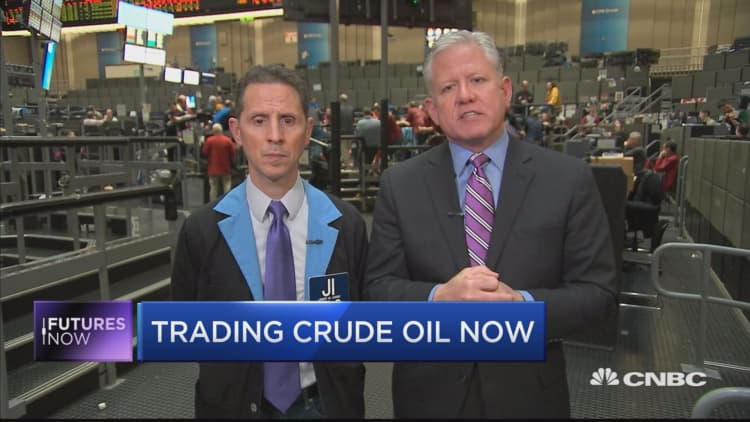Oil futures fell slightly on Wednesday, as a surprise draw in U.S. crude stockpiles boosted prices from session lows hit in early trade after China proposed a broad range of tariffs on U.S. exports that fed fears of a burgeoning trade war.
Both Brent and U.S. crude slid to two-week lows after China, the world's largest importer of raw materials, hit back at the Trump administration's plan to levy tariffs on $50 billion of its goods, proposing duties on a broad range of U.S. imports including soybeans, planes, cars, whiskey and chemicals.
U.S. West Texas Intermediate crude futures ended Wednesday's session 14 cents lower at $63.37 a barrel, rebounding from a session low of $62.06.
Brent crude futures were down 5 cents at $68.07 per barrel by 2:25 p.m. ET. The contract earlier fell as low as $66.69.
Prices pared losses after the Energy Information Administration released data showing U.S. crude inventories fell by 4.6 million barrels in the latest week. Analysts had expected an increase of 246,000 barrels.
"The report was mostly supportive with strong demand for crude oil from the 93 percent refinery utilization rate and the high level of crude oil exports of over 2 million barrels per day," said John Kilduff, partner at energy hedge fund Again Capital LLC in New York.
The drop in inventories came as refinery crude runs rose by 141,000 barrels per day, EIA data showed. Refinery utilization rates rose by 0.7 percentage point.
However, crude stocks at the Cushing, Oklahoma delivery hub rose by 3.7 million barrels, EIA said.
U.S. crude production continued to surge, hitting a new weekly record of 10.46 million barrels per day (bpd) compared with 10.43 million bpd last week.
Meanwhile, OPEC oil output fell in March to an 11-month low due to declining Angolan exports, Libyan outages and a further slide in Venezuelan output, a Reuters survey found, sending compliance with a supply-cutting deal to another record.
Russian Energy Minister Alexander Novak said on Tuesday that a joint organization between the Organization of the Petroleum Exporting Countries and non-OPEC countries may be set up after the current deal on production cuts expires at the end of this year.

"Russia is testing the upper production bands but provided they don't ramp up dramatically I think this news will be viewed in a positive light for prices," said Stephen Innes, head of trading for Asia/Pacific at futures brokerage OANDA in Singapore.
Oil has risen from a multi-year low near $27 a barrel in January 2016, helped by production cuts led by OPEC and Russia, which began in 2017 in order to rein in over-supply and prop up prices.
Top producer Russia's oil output rose in March to 10.97 million barrels per day, up from 10.95 million bpd in February, official data showed earlier this week, prompting some traders to worry the OPEC-non-OPEC alliance to help balance oil markets was under threat.
Yet fund managers hold more bets on a sustained rise in the price of Brent crude oil than at any time, data from the InterContinental Exchange shows.
The net long position in futures and options now tops 600 million barrels of oil, the data shows, meaning that in the event of a sharper drop in price, sellers may find a dearth of buyers.
"What's really the main worry is that the long/short ratio is so skewed, meaning who is going to be buying if there is a lot of selling pressure?" Saxo Bank head of commodities strategy Ole Hansen said.
— CNBC's Tom DiChristopher contributed to this report.

